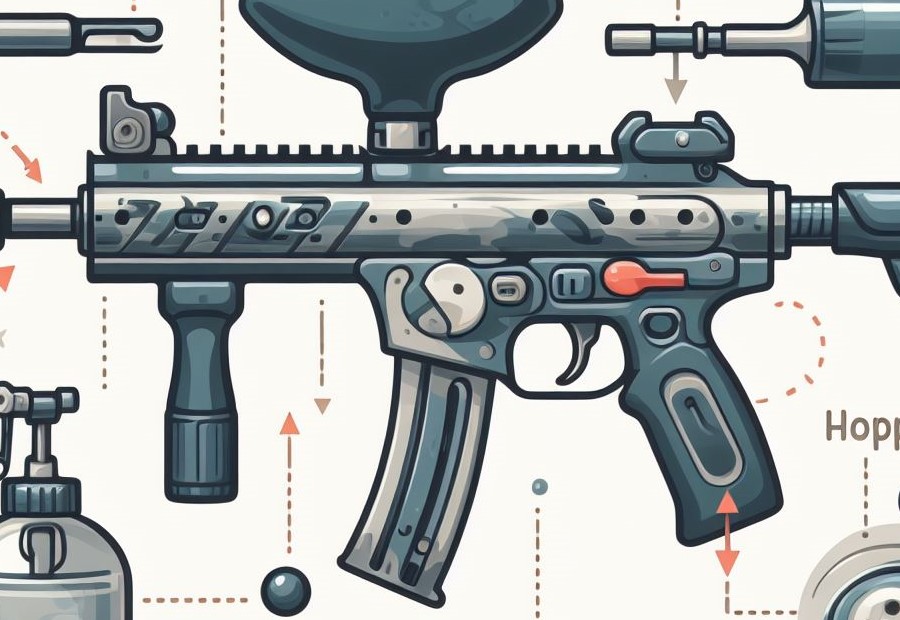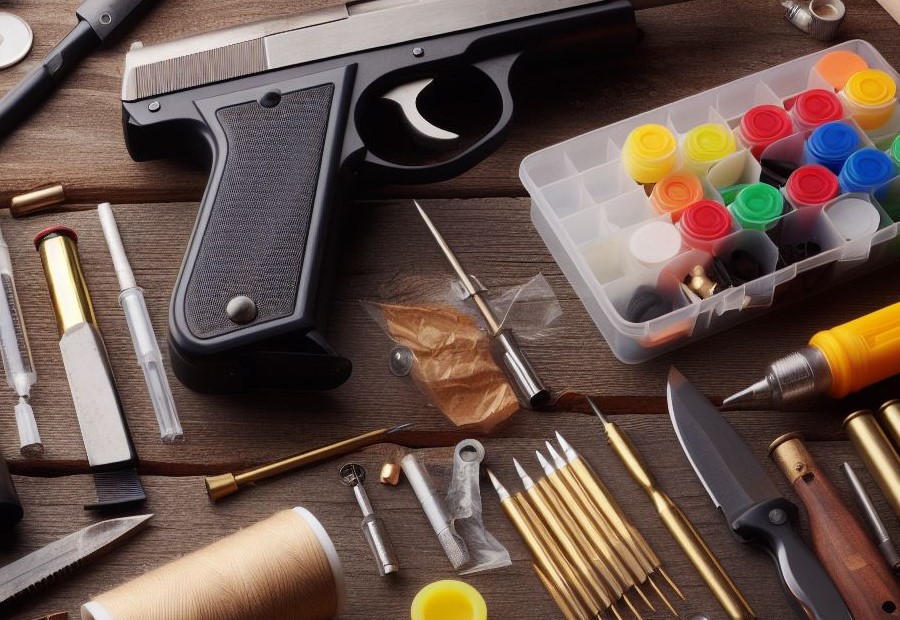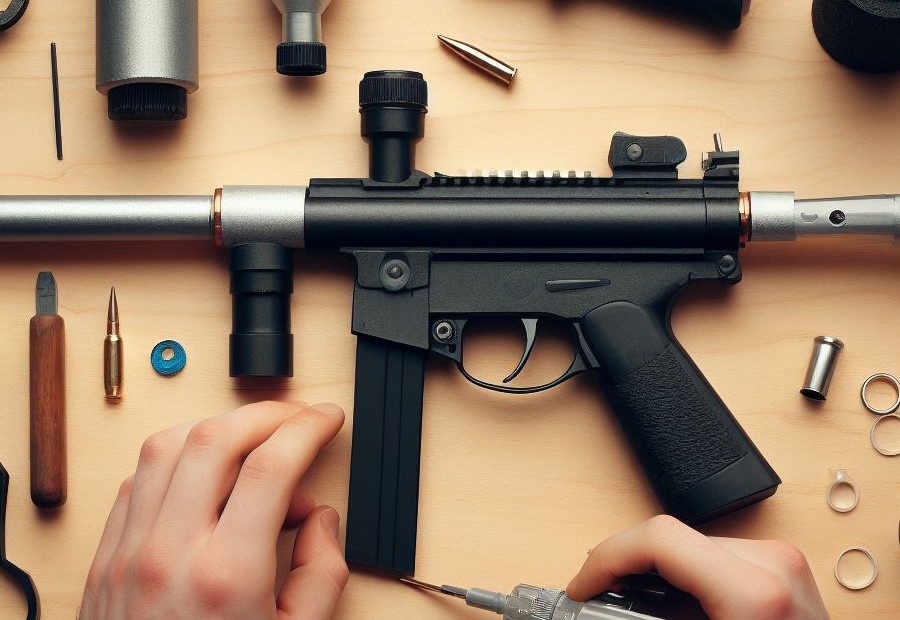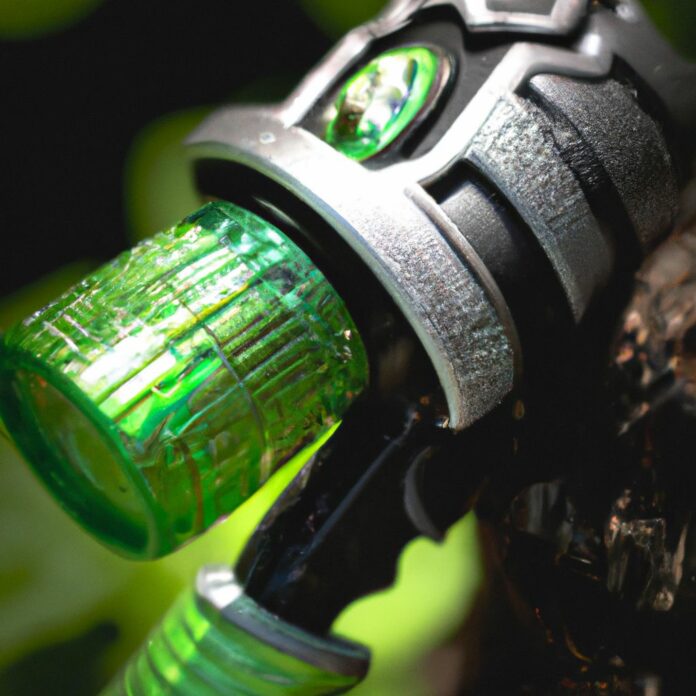Creating a homemade paintball gun can be a fun and rewarding project for paintball enthusiasts. Not only does it allow you to customize your own equipment, but it also gives you a sense of accomplishment.
Before you embark on this DIY endeavor, it’s essential to understand the basics of a paintball gun. A study by the Journal of Applied Biomechanics conducted by Mark G. Geil and James D. LeNoble delves into the mechanics and principles of a paintball gun.
This article will provide a step-by-step guide on how to make a homemade paintball gun, including designing the body, creating the air chamber, assembling the trigger mechanism, adding a barrel and loader, and testing and adjustments.
Safety precautions and legal considerations will also be discussed to ensure a responsible and legally compliant approach to homemade paintball guns.
Lastly, we will explore alternative options available for those who prefer commercially manufactured paintball guns.
Understanding the Basics of a Paintball Gun

Understanding the basics of a paintball gun is essential for anyone interested in the sport. The key components of a paintball gun consist of the marker, the air tank, the hopper, and the barrel. The marker serves as the primary part of the gun that propels the paintballs, and it operates using compressed air or CO2 from the air tank.
The hopper is responsible for holding the paintballs and feeding them into the marker, while the barrel contributes to the accuracy and distance of your shots. It is vital to select a paintball gun that aligns with your preferred style of play, whether it is speedball or woodsball, and to properly maintain it for optimal performance.
Having a thorough comprehension of how to clean, lubricate the marker, and adjust the velocity will aid in extending its longevity. By acquainting yourself with the fundamentals of a paintball gun, you can enhance your ability to handle and operate it safely on the field.
True story: I can vividly recall my first experience playing paintball, and during that time, I possessed no understanding of the basics of a paintball gun. I impulsively grabbed a marker without any knowledge of loading the paintballs correctly or adjusting the hopper. Consequently, I encountered multiple jams and wasted more time attempting to fix my gun than actually participating in the game. This served as an invaluable lesson for me, highlighting the importance of comprehending the fundamentals of any equipment before using it in a competitive setting.
How Does a Paintball Gun Work?
A paintball gun works by using compressed air or gas to propel paintballs at high speeds. The gun has several components that work together to achieve this.
First, there is a container called an ammo tank that holds the paintballs. When the trigger is pulled, it releases a burst of air or gas, pushing the paintballs out of the barrel. The burst of air or gas is controlled by a valve, which opens and closes to release the pressure.
The trigger mechanism is another important part of how a paintball gun works. When the trigger is pulled, it activates a sear that holds the valve in place. When the sear is released, it allows the valve to open and let out the burst of air or gas.
The barrel of the paintball gun is also crucial. It provides a pathway for the paintballs to travel through, and its length and diameter can affect the accuracy and speed of the shots. How does a paintball gun work?
Materials and Tools Required for Making a Homemade Paintball Gun

Get ready to dive into the exciting world of making your own homemade paintball gun! In this section, we’ll explore the materials and tools essential for this thrilling DIY project. Discover what you’ll need to get started and become equipped with the necessary knowledge to create your very own paintball gun masterpiece. So, let’s roll up our sleeves and unleash our creativity with homemade paintball gun crafting!
What You’ll Need to Get Started
To get started on making a homemade paintball gun, here is a list of what you’ll need:
- A PVC pipe, preferably around 15 centimeters long, to serve as the body of the gun.
- A tire valve or a tire replacement valve to create the air chamber.
- A power drill to drill a hole into the PVC pipe for the air chamber.
- A hand drill to create a smaller hole for the trigger mechanism.
- A PVC ball valve to control the airflow.
- Elastic or surgical tubing to connect the air chamber and trigger mechanism.
- A plastic bottle, such as a reusable plastic bottle or a heavy plastic drink bottle, to act as the ammo tank.
- Safety glasses to protect your eyes during the construction process.
- Basic materials like zip ties, electrical tape, and super glue to secure the different parts together.
Pro-tip: Before starting this DIY project, it’s important to emphasize that homemade paintball guns have legal and ethical considerations. It’s essential to use them responsibly and ensure you are in compliance with local laws and regulations regarding paintball markers. Adult supervision is recommended, especially if you’re attempting this as your first project.
Step-by-Step Guide on Making a Homemade Paintball Gun

Looking to create your own paintball gun from scratch? Look no further! This step-by-step guide will walk you through the process, from designing the body and creating the air chamber to assembling the trigger mechanism and adding a barrel and loader. We’ll even cover testing and making necessary adjustments along the way. Get ready to dive into the exciting world of DIY paintball guns and unleash your inner inventor!
Step 1: Designing the Body of the Gun
When designing the body of a homemade paintball gun, it is important to follow these steps:
- Begin by gathering the necessary materials and tools, including a PVC pipe, cotter pin, heavy plastic drink bottles, power drill, and a hand drill.
- Measure and mark the desired length of the body of the gun on the PVC pipe. It is recommended to use a pipe that is approximately 15 centimeters long.
- Use a power drill to carefully drill a hole near one end of the PVC pipe. This hole will serve as the opening for the ammo to be loaded into the gun.
- Next, drill a smaller hole near the opposite end of the PVC pipe. This hole will be used to attach the air chamber to the body of the gun.
- Attach the cotter pin to the side of the PVC pipe. This will act as the trigger mechanism for the gun.
- Using a hot glue gun, secure the heavy plastic drink bottles onto the body of the gun. These bottles will serve as the ammo tank.
- Finally, test the functionality of the gun by adding paintball pellets to the ammo tank and using a hand pump to generate a burst of air. Ensure that the gun fires properly and make any necessary adjustments.
In recent years, many paintball enthusiasts have enjoyed creating their own homemade paintball guns as a fun project and a way to customize their paintball experience. By following these steps, you can design the body of a homemade paintball gun.
Homemade paintball guns have been a popular DIY project among paintball players for many years. They provide a unique and customizable alternative to store-bought paintball guns. The first homemade paintball guns were created in the 1980s when the sport of paintball was still in its early stages.
Since then, advancements in technology and the availability of tools and materials have made it easier than ever to design the body of a homemade paintball gun. Today, there are countless variations and designs that paintball players can explore when making their own guns.
Step 2: Creating the Air Chamber
When crafting a homemade paintball gun, the next task is to construct the air chamber. Follow these instructions:
- Collect all the necessary materials and tools.
- Take a PVC pipe, roughly 15 centimeters long, and seal one end using a PVC end cap and super glue.
- Create a small hole in the cap and install a tire valve, securing it with hot glue or super glue.
- Attach a piece of surgical tubing to the opposite end of the PVC pipe, ensuring a tight seal.
- Connect the other end of the surgical tubing to the firing mechanism of the paintball gun.
- Inspect for any air leaks and remedy them using electrical tape or plumbers tape.
- Test the air chamber by pressurizing it with either a hand pump or an air compressor.
- Ensure that the air chamber is firmly attached to the rest of the paintball gun.
- Proceed to the subsequent step in constructing your homemade paintball gun.
The creation of the air chamber is a crucial undertaking in building a functional homemade paintball gun. It supplies the necessary pressure for accurately propelling the paintball. Take your time and meticulously inspect all connections and seals to ensure a safe and efficient paintball gun.
Step 3: Assembling the Trigger Mechanism
When assembling the trigger mechanism for your homemade paintball gun, follow these steps:
- Start by gathering all the necessary materials, including a mini machine shop, a plastic syringe, a power drill, a pvc pipe, a pvc ball valve, a wide metal pipe, a cotter pin, electrical tape, and super glue.
- Using a power drill, create a small hole in the pvc pipe to act as the trigger mechanism.
- Attach the plastic syringe to the pvc pipe, securing it with super glue.
- Add the pvc ball valve to the other end of the pvc pipe and secure it tightly.
- Insert the cotter pin into the pvc ball valve, ensuring it is secure and won’t come loose during use.
- Wrap electrical tape around the trigger mechanism to enhance grip and comfort.
- Test the trigger mechanism by pulling the trigger and observing if it releases the burst of air or gas required for firing the paintball gun.
Step 4: Adding a Barrel and Loader
To add a barrel and loader to your homemade paintball gun, follow these steps:
1. Begin by measuring the length of the barrel you want to attach to your gun.
2. Use a power drill to carefully create a hole in the body of the gun that matches the diameter of the barrel.
3. Insert one end of the barrel into the hole, ensuring a secure fit.
4. Affix the barrel to the gun using either zip ties or screws, depending on the materials you are working with.
5. Moving on to the loader, start by acquiring a wide metal pipe and attaching it to the top of the gun using screws or adhesive.
6. Create a small hole near the base of the pipe, allowing the paintballs to enter the gun smoothly.
7. Attach a hopper or container to the loader, which will serve as the paintball reservoir.
8. Make sure the loader is firmly secured to the gun and that the paintballs can effortlessly feed into the barrel.
I made the decision to construct my own paintball gun from scratch, and the process of adding the barrel and loader was exhilarating. After taking precise measurements and drilling the hole for the barrel, I felt a sense of fulfillment when it fit flawlessly. Installing the loader posed a bit more of a challenge, but with some ingenuity, I managed to attach it securely and ensure seamless paintball feeding.
Witnessing my homemade paintball gun come together, complete with the barrel and loader, was a truly gratifying experience, both aesthetically and functionally resembling an authentic paintball marker. I eagerly anticipated testing it out on the field and showcasing my DIY skills to my friends during our next paintball outing.
Step 5: Testing and Adjustments
When it comes to making a homemade paintball gun, Testing and Adjustments involves the crucial process of testing and making adjustments to ensure the gun functions properly. Follow these steps:
- Securely attach the air source and any necessary components to the gun.
- Load the gun with a paintball pellet.
- Aim at a safe target and prepare to test fire the gun.
- Activate the trigger mechanism to release a burst of air or gas and propel the paintball.
- Observe the trajectory, speed, and accuracy of the shot.
- Check for any air leaks or malfunctions in the gun’s mechanisms.
- Adjust the air pressure or trigger mechanism as needed to achieve the desired performance.
- Repeat the testing and adjustment process multiple times to ensure consistency.
Remember to always wear safety glasses and follow proper safety precautions during testing to avoid accidents or injuries.
Safety Precautions and Considerations

Before diving into the thrilling world of homemade paintball guns, it’s crucial to understand the importance of safety precautions and considerations. In this section, we’ll explore the essential safety tips that should be followed to ensure your paintball adventure remains fun and injury-free. From protective gear recommendations to field guidelines, we’ll equip you with the knowledge needed to enjoy this exciting sport while keeping yourself and others safe. So buckle up and let’s learn the safety ropes of homemade paintball gun fun!
Important Safety Tips to Follow
- Always wear safety glasses to protect your eyes from potential injuries.
- Inspect the homemade paintball gun for any air leaks before using it.
- Only use pressure-rated materials to ensure the gun can handle the force of firing.
- Handle the gun with care and avoid pointing it at anyone or anything you don’t intend to shoot.
- Store the homemade paintball gun in a safe and secure location, away from children or unauthorized individuals.
It is crucial to prioritize safety when using a homemade paintball gun to prevent accidents or injuries. Following these important safety tips will help ensure a safe and enjoyable paintball experience.
Fact: According to Paintball Sports Trade Association, paintball is one of the fastest-growing sports in the world, with millions of enthusiasts participating each year.
Legal and Ethical Considerations of Homemade Paintball Guns

Homemade paintball guns may seem like a fun project, but it is crucial to understand the legal and ethical considerations involved. Legally, creating and using homemade paintball guns can be problematic due to the potential safety risks and legal consequences involved in their use.
Ethically, using homemade paintball guns raises questions about precision, accuracy, and unintended targets being hit, causing harm or distress to individuals who are not participants in the game. Furthermore, homemade guns may lack necessary safety features, putting players at risk.
Considering these factors, it is important to prioritize safety and adhere to regulations when participating in paintball activities. Instead of making homemade paintball guns, it is advisable to purchase commercially available guns that are designed and manufactured to meet safety standards.
These guns have undergone testing and are approved for use in paintball games, ensuring a safer and more enjoyable experience for all participants. Remember, it is always best to prioritize safety and act responsibly when engaging in any recreational activity.
Alternatives to Making a Homemade Paintball Gun
When it comes to paintball, safety should always be a top priority. Instead of making a homemade paintball gun, consider these alternatives to ensure the safety of yourself and others:
- Purchase a professionally-made paintball gun from a reputable manufacturer. This ensures the gun has undergone proper testing and meets safety standards.
- Visit a paintball facility or recreational center that provides paintball equipment for rent. This allows you to enjoy the sport without the need to make your own gun.
- Join a local paintball club or team. Many clubs have equipment available for members to use during games or practice sessions.
- Consider alternative activities that provide similar excitement but without the need for a gun, such as laser tag or airsoft.
In the early days of paintball, players often resorted to making their own guns using various materials. However, as the sport grew in popularity and safety became a concern, regulations were put in place to ensure the use of properly manufactured guns. Today, paintball is enjoyed by millions around the world using safe and reliable equipment.
Frequently Asked Questions
How do I make a homemade paintball gun with rotating barrels?
Building a paintball gun with rotating barrels requires advanced knowledge and skills in mechanical engineering. It is not recommended for beginners or inexperienced individuals to attempt this project without proper guidance and understanding of the mechanics involved.
What materials do I need to gather to make a homemade paintball gun?
To make a basic model of a homemade paintball gun, you will need PVC pipes and fittings such as a PVC reducer, PVC nipple, PVC tee, and PVC elbow. Other materials include a plastic bottle, a bendy lighter, a metal pipe, a drill, a hot glue gun, and an aerosol deodorant.
How do I finish up the construction of a homemade paintball gun?
To finish up the construction of a homemade paintball gun, you need to attach the lid tightly to the plastic bottle and secure the bendy lighter to the side of the bottle using hot glue. Make sure all parts are properly assembled and double-check for any loose connections or leaks before proceeding to fire the paintball gun.
How much paint does a 750 ml plastic bottle homemade paintball gun hold?
The paintball gun made from a 750 ml plastic bottle is not designed to hold paintballs. It operates by using a burst of gas, such as aerosol deodorant, to propel the paintball out of the metal pipe. The bottle functions as a chamber for the gas, not as a container for paintballs.
Can I use a water balloon instead of a paintball in a homemade paintball gun?
It is not recommended to use a water balloon instead of a paintball in a homemade paintball gun. Water balloons are not designed for this purpose and may cause unpredictable and unsafe results. It is essential to use the appropriate projectiles, such as paintballs, specifically made for paintball guns for safety reasons.

